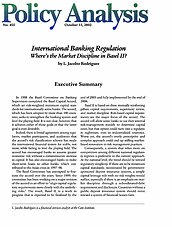In 1988 the Basel Committee on Banking Supervision completed the Basel Capital Accord, which set risk-weighted minimum capital standards for internationally active banks. The accord, which has been adopted by more than 100 countries, seeks to strengthen the banking system and level the playing field. It is not clear, however, that it achieves either of those goals or that the latter goal is even desirable.
Indeed, there is broad agreement among regulators, market participants, and academics that the accord’s risk classification scheme has made the international financial system less stable, not more, while failing to level the playing field. The accord has encouraged banks to assume greater economic risk without a commensurate increase in capital. It has also encouraged banks to make short-term loans to other banks, which contributed to the Asian crisis in 1997–98.
The Basel Committee has attempted to fine-tune the accord over the years. Since 1999, the committee has been working on a major revision of the accord in an effort to “align capital regulatory requirements more closely with the underlying risks.” The result, Basel II, is a work in progress that is expected to be finalized by the end of 2003 and fully implemented by the end of 2006.
Basel II is based on three mutually reinforcing pillars: capital requirements, supervisory review, and market discipline. Risk-based capital requirements are the major focus of the accord. The accord will allow some banks to use their internal risk-management models to determine capital costs, but that option could turn into a regulatory nightmare, even in industrialized countries. Worse yet, the accord’s overly prescriptive and complex approach could end up stifling market-based innovation in risk management practices.
Consequently, a system that relies more on competition among different national regulatory regimes is preferable to the current approach. At the national level, the trend should be toward regulatory simplicity. If there are to be minimum capital standards, necessitated by government-sponsored deposit insurance systems, a simple capital leverage rule with no risk weights would suffice, especially if there is an emphasis on market discipline through a subordinated-debt requirement and disclosure. Countries without a public deposit insurance system should move toward a system of financial laissez-faire.

This work is licensed under a Creative Commons Attribution-NonCommercial-ShareAlike 4.0 International License.

